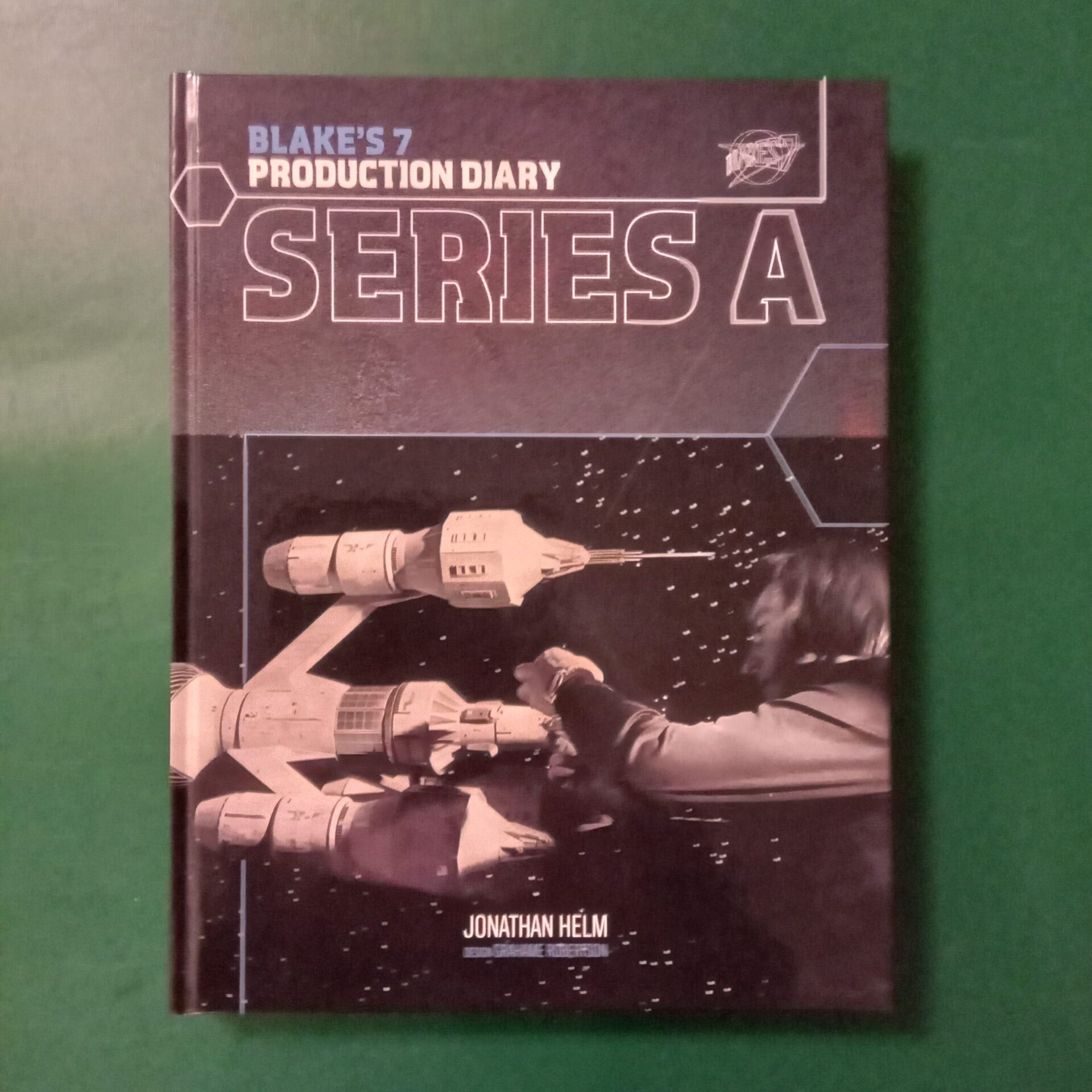“Isn’t that the book that you were writing 30 years ago?” asked my dear friend Hilary.
We were discussing a new volume about Blake’s 7 (1978-1981), the BBC science-fiction adventure series that ran between the dates that I just put in that bracket after its name and which was now being chronicled in a rather superb and brilliant and lavish new book – Blake’s 7 – Production Diary: Series A (2023) – that my wife and I had just treated ourselves to for Christmas.
Blake’s 7 is a rather special show for me. It was even on that daft list of around about 100 of my favourite shows that I assembled for the last blog and – which I’m told – some people actually took seriously. It’s a show that I was there enjoying from Day One… and I hate typing that clause because immediately it conjures up images of the sort of devotee who holds several degrees in gatekeeping, turning away eager new acolytes from a rather fun source material thanks to the chronology of their birth, a factor over which they naturally had no control. So, let’s get one thing straight – my idea of gatekeeping is to unlock the gates and leave them wide open while I go off to have a cup of tea, and everyone else can go in and have all the fun to be had. Hilary was there on Day One, albeit on a different continent, thus in the pre-internet global streaming days unable to enjoy the drama and delight of Blake and his band of galactic rebels… but very quickly when we met on Day Two-Hundred-and-Eighty-One, she was soon joining in the fun as if she’d been there on Day One anyway.
And the book I was doing. Yes. Don’t bother looking for a cheap one on Abe Books. It never happened. Well, bits of it did. But not as a book.
Back in 1991, the market for tomes on ‘Archive TV’ was just gathering momentum. Doctor Who (1963-1989 at the time) was doing very well for Virgin Books, while volumes on The Avengers (1961-1969 or maybe 1977 at a push) and The Prisoner (1967-1968) had been released into the wild to appreciative niche audiences. There’d been a Blake’s 7 book before – Tony Attwood’s Blake’s 7 – The Programme Guide (1982) – but by the start of 1991, BBC Enterprises had commenced the release of all 52 episodes in a reasonably well-promoted series of VHS videotapes… and Virgin Books decided that they could use this to diversify into other series. They contacted Doctor Who Magazine – whom they were working with – and its editor John Freeman recommended me as he knew that I was researching all manner of ‘telefantasy’ shows. In turn, I brought in PrimeTime writer Neil Alsop – somebody else who’d been there on Day One – and who had written for Virgin’s amazing but abortive venture The Television Yearbook (1985 – and well worth getting if it’s on Abe Books).
So, we went down to That London to meet the Virgin team, and then we went to a live broadcast of Tonight with Jonathan Ross (1990-1992) on which several of the Blake’s 7 cast were appearing… and, yes, they were well up for helping on the text [1]. And we started assembling bits of text and contacting people… right up to the point where Virgin said that they’d been unable to get a licence and the book would have to be unlicensed and we said thank you but no and dropped out.
I then took my portion of the text and reworked it for potential use elsewhere with Una McCormack – another ardent fan of the show whom I’d met during the initial research phase. And that went nowhere through most of 1992.
In 1993, the unused text proved useful to director Kevin Jon Davies when he spent a few months working on the BBC Enterprises documentary Blake’s 7: Good and Evil. But, as it turned out, that hit rights problems too, was parked until around 2002, reactivated again, hit more rights problems, and is still currently in home release limbo.
By 1994, Marvel UK had, for some reason, acquired the publishing rights for Blake’s 7 material. There were poster magazines – how 70s could you get? – and talk of an annual, whereupon the editor, Gary Russell, kindly said “Hey! Andrew! Can you turn bits of that unpublished book into text for an annual?” So, I re-edited the text again, and that didn’t happen either… but eventually the bits that we’d rejigged for an annual found their way into a couple of rather beautifully presented magazines.
And that was that.
Now, along the way, I’d been given access to all manner of visuals that – because of the different versions of the project at different times – we’d just not been able to use. Production paperwork, design sketches, studio footage, set photos, etc. etc. All very nice and lovely and super – but just beyond the remit of whatever incarnation of a home for this text I’d been looking for at that particular moment.
And here’s the other problem. I don’t think visually. Ironic isn’t it – I write about television but I never consider the pictures. That’s why I rely on amazing designers. My rather dull objective is just to locate, assemble and package the data. If I can weave a story or a shape around the skeleton of the data, well, that’s an added bonus – but frankly that’s a lesser objective to my tunnel-minded perspective. As such, I pay scant attention to illustrations.

Fig. 2: PLACEHOLDER! I’ll send a caption later for whatever it turns out to be. I can’t be bothered to think about it now.
So, when you come across a volume that blends data and imagery – then, WOW!, this is terrific.
And that’s just what Blake’s 7 – Production Diary: Series A is.
This rather terrific tome has been assembled as a day-by-day chronicle of production on the first thirteen-episode run of Blake’s 7 by Jonathan Helm, a writer whose work I’ve admired elsewhere because he’s got a talent for being able to take a very tricky technical subject and to communicate it deftly and quickly using just two or three well-chosen examples. Wonderful stuff. And his collection of dates and times and – get this! – image, has all been assembled with terrific design expertise by Grahame Robertson.
The result is something that functions on many levels.
If you want to understand more about how traditional film-VT drama of this era worked – or, indeed, if you’re young enough, what I even mean by ‘traditional film-VT drama’ – then this is the book for you. You’ll learn about SYPHER dubbing and everything. And the sequence that they’re done in. And how you need to cover the gaps when somebody is off making The Professionals (1977-1983) instead of being at the BBC Television Film Studio in Ealing. And what the BBC Television Film Studios in Ealing was in the first place.
And to do this, it won’t just use lots of words in a chronological assembly that looks like a dull 1970s school textbook… it depicts the source of all the data. Memos, draft scripts, rehearsal scripts, film schedules, camera scripts, set photographs, frames of film with clapperboards on them, newspaper cuttings – the actual planning documents and resultant components that created popular television. But not just tabulated lifelessly… all intermingled so that you can see how a specific paragraph of script was brought to life, or how a key sequence was assembled from several different shoots.
In other words, it tells a story.
And the story is also given a richness, full of real-life characters playing out the events. It’s not just camera line-up times and rehearsal days – it’s the events springing to life via the well-chosen quotes of the people whose names were at the top, bottom and across the middle of the memos and scripts, recounting the experience of how the infinity of outer space was built on the same budget as the HQ of the Thamesmead Constabulary of DCS John Watt… and all the trials and tribulations along the way.
It’s vividly and brilliantly bringing TV history to life in an accessible way… and for even those of us who were there on Day One, it’s allowing us to admire it even more, to see it afresh and to understand the processes and talent that took us off on the intergalactic adventures of our youth.
So, Hilary, as always in all the forty years I’ve known you, it was a good question. And I think that I finally have the answer.
No, it’s not the book I was writing 30 years ago.
It’s a vastly better one.
Andrew Pixley is a retired data developer. For the last 30 years he’s written about almost anything to do with television if people will pay him – and occasionally when they won’t. Oh, and possibly the most important aspect of Blake’s 7 – Production Diary: Series A, more important than the dates and the design sketches and the scripts and the frames of film… is that within a fortnight or so of publication, this amazing not-for-profit book had raised £1,000 for UNICEF and The Alzheimer’s Society. Which is something I think we’re all agreed is far more important than an old TV show.
Footnote
[1] In addition to which, during the warm-up Steve Nieve and The Love Band played Laurie Johnson’s theme to The Avengers (1965-1969). RIP Laurie.






Yet another work you’ve referenced which I need to somehow get hold of– my academic self thanks you (but my straining bookshelf begs for mercy). ;P
Ooooohhhh… it’s a good ‘un Melissa. It was a real treat for us to buy and a real treat for us to read. Very specialist and so wonderfully done with no commercial intent at all… clearly just people wanting to do it for the sheer love of the experience…
… and, yes, so many lovely books and not enough shelf space. Mind you, so much lovely television that I’ll probably never get around to watching! Like “Harvey Birdman: Attorney at Law” for example! Nice one! 🙂
All the best
Andrew
I’ll definitely keep my eyes open for a copy in my general vicinity. (I almost said ‘orbit’ but I remember what happens in that episode of Blakes 7, so… 😉
A wonderful piece of Holmesian genius! 🙂
All the best
Andrew